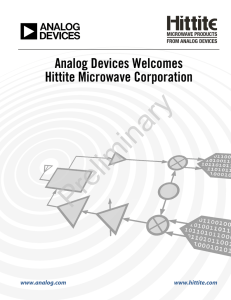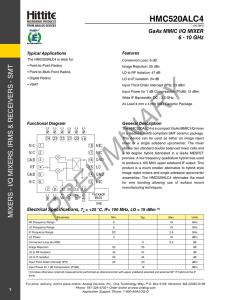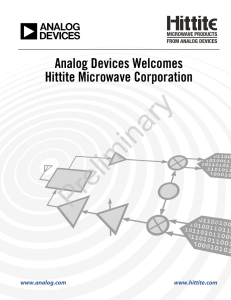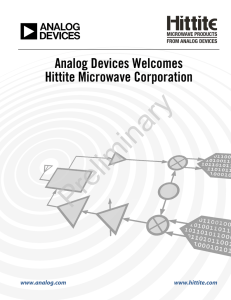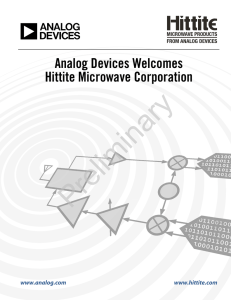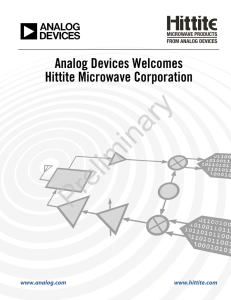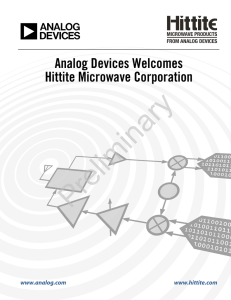HMC560A
advertisement
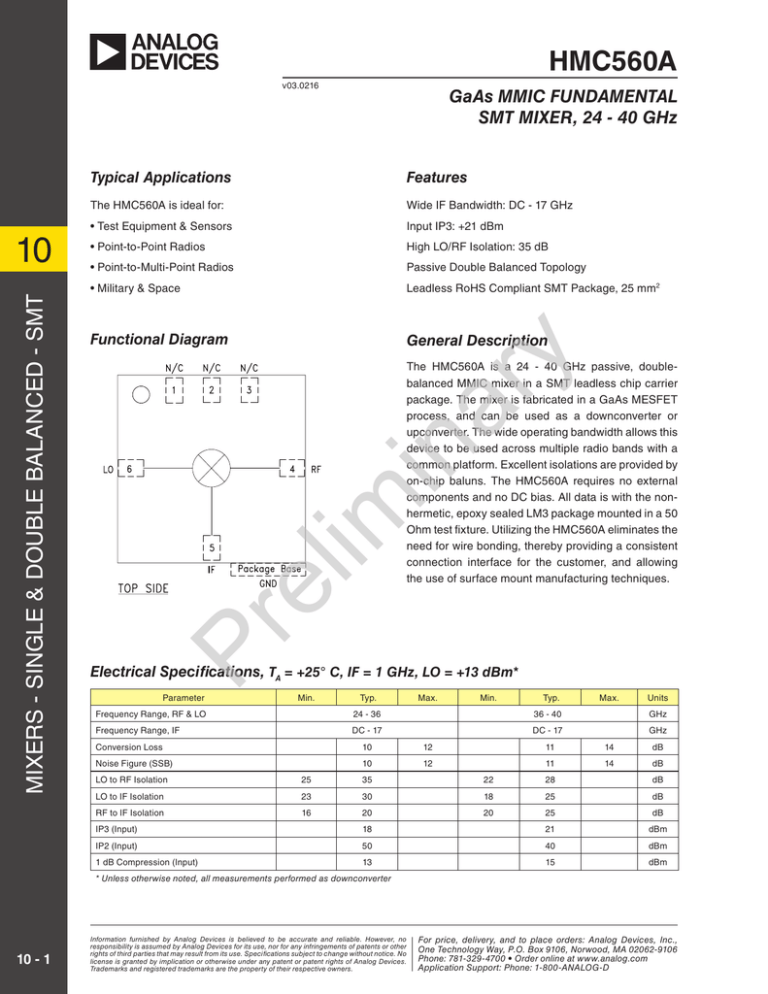
HMC560A v03.0216 Features The HMC560A is ideal for: Wide IF Bandwidth: DC - 17 GHz • Test Equipment & Sensors Input IP3: +21 dBm • Point-to-Point Radios High LO/RF Isolation: 35 dB • Point-to-Multi-Point Radios Passive Double Balanced Topology • Military & Space Leadless RoHS Compliant SMT Package, 25 mm2 Functional Diagram General Description y Typical Applications The HMC560A is a 24 - 40 GHz passive, doublebalanced MMIC mixer in a SMT leadless chip carrier package. The mixer is fabricated in a GaAs MESFET process, and can be used as a downconverter or upconverter. The wide operating bandwidth allows this device to be used across multiple radio bands with a common platform. Excellent isolations are provided by on-chip baluns. The HMC560A requires no external components and no DC bias. All data is with the nonhermetic, epoxy sealed LM3 package mounted in a 50 Ohm test fixture. Utilizing the HMC560A eliminates the need for wire bonding, thereby providing a consistent connection interface for the customer, and allowing the use of surface mount manufacturing techniques. in ar im Pr el MIXERS - SINGLE & DOUBLE BALANCED - SMT 10 GaAs MMIC FUNDAMENTAL SMT MIXER, 24 - 40 GHz Electrical Specifications, TA = +25° C, IF = 1 GHz, LO = +13 dBm* Parameter Min. Typ. Frequency Range, RF & LO 24 - 36 Frequency Range, IF DC - 17 Max. Min. Typ. Max. 36 - 40 Units GHz DC - 17 GHz Conversion Loss 10 12 11 14 dB Noise Figure (SSB) 10 12 11 14 dB LO to RF Isolation 25 35 22 28 dB LO to IF Isolation 23 30 18 25 dB RF to IF Isolation 16 20 20 25 dB IP3 (Input) 18 21 dBm IP2 (Input) 50 40 dBm 1 dB Compression (Input) 13 15 dBm * Unless otherwise noted, all measurements performed as downconverter 10 - 1 Information furnished by Analog Devices is believed to be accurate and reliable. However, no responsibility is assumed by Analog Devices for its use, nor for any infringements of patents or other rights of third parties that may result from its use. Specifications subject to change without notice. No license is granted by implication or otherwise under any patent or patent rights of Analog Devices. Trademarks and registered trademarks are the property of their respective owners. For price, delivery, and to place orders: Analog Devices, Inc., One Technology Way, P.O. Box 9106, Norwood, MA 02062-9106 Phone: 781-329-4700 • Order online at www.analog.com Application Support: Phone: 1-800-ANALOG-D HMC560A v03.0216 GaAs MMIC FUNDAMENTAL SMT MIXER, 24 - 40 GHz MxN Spurious Outputs as a Down Converter Absolute Maximum Ratings +25 dBm LO Drive +23 dBm IF DC Current Channel Temperature Continuous Pdiss (T= 85 °C ) (derate 5.3 mW/ °C above 85 °C) nLO mRF 0 1 ±2 mA 0 xx -5 5 150 °C/W 1 3 0 25 2 58 48 49 0.344 W 3 78 2 4 10 58 73 63 83 88 85 89 Thermal Resistance (RTH) (channel to package bottom) 188 °C/W Storage Temperature -65 to +150 °C LO = 25 GHz @ +13 dBm Operating Temperature -55 to +85 °C All values in dBc below IF output power level. 4 3 in ar ELECTROSTATIC SENSITIVE DEVICE OBSERVE HANDLING PRECAUTIONS y RF = 24 GHz @ -10 dBm Pr el im Outline Drawing NOTES: 1. MATERIAL: PLASTIC 2. PLATING: GOLD OVER NICKEL 3. ALL DIMENSIONS IN INCHES (MILLIMETERS) 4. ALL TOLERANCES ARE ±0.005 (±0.13) 5. ALL GROUNDS MUST BE SOLDERED TO PCB RF GROUND 6. INDICATES PIN 1 MIXERS - SINGLE & DOUBLE BALANCED - SMT RF / IF Input • For price, delivery, and to place orders: Analog Devices, Inc., One Technology Way, P.O. Box 9106, Norwood, MA 02062-9106 Phone: 781-329-4700 • Order online at www.analog.com Application Support: Phone: 1-800-ANALOG-D 10 - 4 HMC560A v03.0216 GaAs MMIC FUNDAMENTAL SMT MIXER, 24 - 40 GHz Pin Descriptions 10 - 5 Description 1, 2, 3 N/C This pin may be connected to the PCB ground or left unconnected. 4 RF This pin is DC coupled and matched to 50 Ohms. 5 IF This pin is DC coupled. For applications not requiring operation to DC, this port should be DC blocked externally using a series capacitor whose value has been chosen to pass the necessary IF frequency range. For operation to DC, this pin must not source or sink more than 2 mA of current or part non-function and possible part failure will result. 6 LO This pin is DC coupled and matched to 50 Ohms. in ar im GND Interface Schematic y Function Package base must be soldered to PCB RF ground. Pr el MIXERS - SINGLE & DOUBLE BALANCED - SMT 10 Pin Number For price, delivery, and to place orders: Analog Devices, Inc., One Technology Way, P.O. Box 9106, Norwood, MA 02062-9106 Phone: 781-329-4700 • Order online at www.analog.com Application Support: Phone: 1-800-ANALOG-D HMC560A v03.0216 GaAs MMIC FUNDAMENTAL SMT MIXER, 24 - 40 GHz Evaluation PCB Pr el The grounded Co-Planar Wave Guide (CPWG) PCB input/output transitions allow use of Ground-Signal-Ground (GSG) probes for testing. Suggested probe pitch is 400 mm (16 mils). Evaluation Circuit Board Layout Design Details Layout Technique Micro Strip to CPWG Material Rogers 4003 with 1/2 oz. Cu Dielectric Thickness 0.008” (0.20 mm) Microstrip Line Width 0.018” (0.46 mm) CPWG Line Width 0.016” (0.41 mm) CPWG Line to GND Gap 0.005” (0.13 mm) Ground Via Hole Diameter 0.008” (0.20 mm) MIXERS - SINGLE & DOUBLE BALANCED - SMT im in ar y 10 LM3 package mounted to evaluation PCB For price, delivery, and to place orders: Analog Devices, Inc., One Technology Way, P.O. Box 9106, Norwood, MA 02062-9106 Phone: 781-329-4700 • Order online at www.analog.com Application Support: Phone: 1-800-ANALOG-D 10 - 6 HMC560A v03.0216 GaAs MMIC FUNDAMENTAL SMT MIXER, 24 - 40 GHz Suggested LM3 PCB Land Pattern 10 - 7 y in ar im NOTES: 1. DIMENSIONS ARE IN INCHES [MILLIMETERS] 2. PAD WIDTH SHOWN IS FOR SOLDERING ONLY. BEYOND SOLDERING AREA ALL CONDUCTORS THAT CARRY RF AND MICROWAVE SIGNALS SHOULD HAVE 50 OHM CHARACTERISTIC IMPEDANCE. Pr el MIXERS - SINGLE & DOUBLE BALANCED - SMT 10 For price, delivery, and to place orders: Analog Devices, Inc., One Technology Way, P.O. Box 9106, Norwood, MA 02062-9106 Phone: 781-329-4700 • Order online at www.analog.com Application Support: Phone: 1-800-ANALOG-D HMC560A v03.0216 GaAs MMIC FUNDAMENTAL SMT MIXER, 24 - 40 GHz Recommended SMT Attachment Technique Preparation & Handling of the LM3 Millimeterwave Package for Surface Mounting 10 200 0 175 125 100 75 50 25 8 in ar Cleanliness: Observe proper handling procedures to ensure clean 0 1 2 3 4 5 6 7 TIME (min) devices and PCBs. LM3 devices should remain in their original packaging until component placement to ensure no contamination or damage to RF, DC & ground contact areas. Static Sensitivity: Follow ESD precautions to protect against ESD strikes. General Handling: Handle the LM3 package on the top with a vacuum collet or along the edges with a sharp pair of bent tweezers. Avoiding damaging the RF, DC, & ground contacts on the package bottom. Do not apply excess pressure to the top of the lid. im Solder Materials & Temperature Profile: Follow the information contained in the application note. Hand soldering is not recommended. Conductive epoxy attachment is not recommended. Solder Paste: Solder paste should be selected based on the user’s experience and be compatible with the metalization systems used. See the LM3 data sheet Outline drawing for pin & ground contact metalization schemes. Pr el Solder Paste Application: Solder paste is generally applied to the PCB using either a stencil printer or dot placement. The volume of solder paste will be dependent on PCB and component layout and should be controlled to ensure consistent mechanical & electrical performance. Excess solder may create unwanted electrical parasitics at high frequencies. Solder Reflow: The soldering process is usually accomplished in a reflow oven but may also use a vapor phase process. A solder reflow profile is suggested above. Prior to reflowing product, temperature profiles should be measured using the same mass as the actual assemblies. The thermocouple should be moved to various positions on the board to account for edge and corner effects and varying component masses. The final profile should be determined by mounting the thermocouple to the PCB at the location of the device. Follow solder paste and oven vendor’s recommendations when developing a solder reflow profile. A standard profile will have a steady ramp up from room temperature to the pre-heat temperature to avoid damage due to thermal shock. Allow enough time between reaching pre-heat temperature and reflow for the solvent in the paste to evaporate and the flux to completely activate. Reflow must then occur prior to the flux being completely driven off. The duration of peak reflow temperature should not exceed 15 seconds. Packages have been qualified to withstand a peak temperature of 235°C for 15 seconds. Verify that the profile will not expose device to temperatures in excess of 235°C. MIXERS - SINGLE & DOUBLE BALANCED - SMT 150 y Follow these precautions to avoid permanent damage: 225 TEMPERATURE ( C) The HMC LM3 package was designed to be compatible with high volume surface mount PCB assembly processes. The LM3 package requires a specific mounting pattern to allow proper mechanical attachment and to optimize electrical performance at millimeter wave frequencies. This PCB layout pattern can be found on each LM3 product data sheet. It can also be provided as an electronic drawing upon request from Hittite Sales & Application Engineering. Cleaning: A water-based flux wash may be used. For price, delivery, and to place orders: Analog Devices, Inc., One Technology Way, P.O. Box 9106, Norwood, MA 02062-9106 Phone: 781-329-4700 • Order online at www.analog.com Application Support: Phone: 1-800-ANALOG-D 10 - 8
